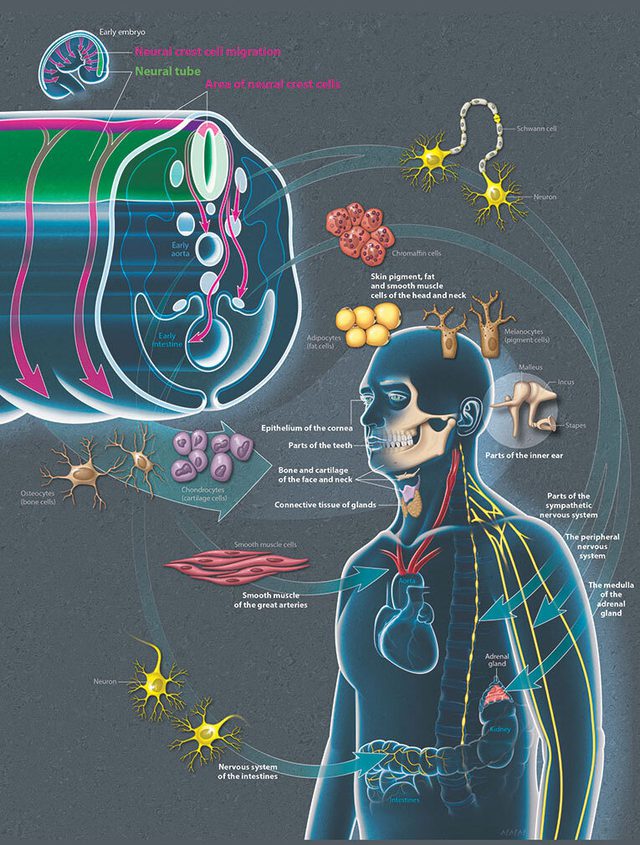News
25 April 2024
Five facts about DNA
What exactly is DNA? And how does it relate to research at the Stowers Institute?
Read Article
News
Learn biological basics of neural crest cells and why scientists at the Stowers Institute study them in our next #BioBasics episode!
Stowers scientists study many different types of cells and processes of development, including a transient cell type critical for proper formation of the head, heart, and nervous system: neural crest cells. Beginning as a single cell, multicellular organisms including humans must make all the cells of the body. Early during vertebrate development, three distinct layers of cells emerge that eventually become different tissues and organs.

Neural crest cells arise at the embryonic brain and spinal cord before migrating throughout the body.
Approximately three to four weeks following conception, the outermost layer forms a new thick slab of cells that then folds in on itself to create the neural tube, which later becomes the brain and spinal cord. Spina bifida, a common congenital condition can occur when the neural tube fails to fully close and can largely be prevented by a standard prenatal supplement of folic acid.
Around this same developmental stage, the neural crest first forms and is sandwiched between the neural tube and the cell layer above it. A complex circuitry including molecular signals, genes, and proteins that help turn genes on, establishes a network that governs the migration and stem cell properties of neural crest cells. Depending on the direction they take, neural crest cells travel to different locations to mature into many cell types including tissues and bones of the head, muscle cells of the heart, and nerve cells throughout the body.

Neural crest cells migrate and mature into many different cell types.
Because these transitional cells form so many critical cells, tissues, and bones, understanding the mechanisms that regulate their formation, proliferation, migration, and maturation is necessary to understand normal vertebrate development and what happens when any one of these steps is disrupted. Both genetic and environmental factors can impact proper neural crest cell development. Inherited mutations in neural crest genes can cause neural crest cell death that manifests as congenital conditions such as cleft palate or Treacher Collins syndrome. Similarly, environmental factors such as alcohol consumption or Zika virus infection during pregnancy can cause improper neural crest cell migration, neural crest cell death, and often craniofacial abnormalities. Neural crest cell migratory and stem cell properties additionally may prime them to turn cancerous, as they are associated with diseases such as neuroblastoma and melanoma.
Scientists at the Stowers Institute are actively investigating how neural crest cells form and change to unlock secrets underlying normal development and how to treat and prevent conditions affecting human health.
This #BioBasics is part of the Institute's #StowersImpact series. To learn more about the impact of our research on congenital conditions, click here.
News
25 April 2024
What exactly is DNA? And how does it relate to research at the Stowers Institute?
Read Article
News
08 August 2024
Learn what chromosomes are and why scientists at the Stowers Institute study them in our next #BioBasics episode!
Read Article
News
04 June 2024
Learn what regeneration is, why scientists at the Stowers Institute study it, and discover the incredible regenerative capacity of research organisms in our latest installment of our #BioBasics series!
Read Article
